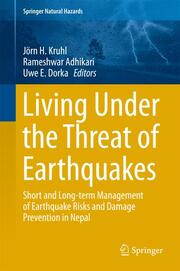Detailansicht
Living Under the Threat of Earthquakes
Short and Long-term Management of Earthquake Risks and Damage Prevention in Nepal, Springer Natural Hazards
ISBN/EAN: 9783319680439
Umbreit-Nr.: 2764309
Sprache:
Englisch
Umfang: xxi, 326 S., 19 s/w Illustr., 85 farbige Illustr.,
Format in cm: 2.5 x 24.2 x 16.1
Einband:
gebundenes Buch
Erschienen am 08.11.2017
Auflage: 1/2018
- Zusatztext
- This book treats earthquakes with a special focus on the Ghorka earthquake which in April 2015 hit central parts of Nepal. Originating from this disastrous event and based on contributions by international experts, various aspects mainly related to earthquakes are closely examined. The topics range from the geological and geophysical background of seismicity, to a detailed inventory of damage caused by the earthquake, ways of damage prevention through earthquake-safe building and settlement, possibilities of restoration of world-heritage buildings and, finally, strategies of technical and medical relief and questions associated with public life and economy in a high-risk seismic zone. Based on contributions from various fields, the book intends to present the state of the art in all earthquake-related fields and to illustrate future ways of perceiving risk, prevention of damage, and disaster management in all parts of society, administration, and politics in Nepal. Beyond the specific disaster in Nepal, these scientific contributions will have wider implications for how societies can and should deal with disasters in general.
- Kurztext
- This book addresses earthquakes, with a special focus on the Ghorka earthquake, which struck parts of central Nepal in April 2015. Drawing on this disastrous event, it closely examines various aspects of earthquakes in contributions prepared by international experts. The topics covered include: the geological and geophysical background of seismicity; a detailed inventory of the damage done by the earthquake; effective damage prevention through earthquake-safe buildings and settlements; restoration options for world-heritage buildings; strategies for providing technical and medical relief and, lastly, questions associated with public life and economy in a high-risk seismic zone. Combining perspectives from various fields, the book presents the state of the art in all earthquake-related fields and outlines future approaches to risk identification, damage prevention, and disaster management in all parts of society, administration, and politics in Nepal. Beyond the specific disaster in Nepal, the findings presented here will have broader implications for how societies can best deal with disasters.
